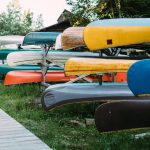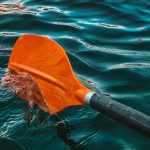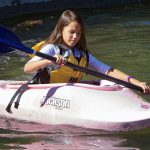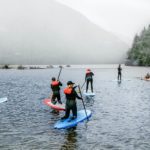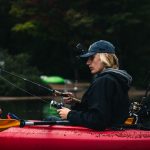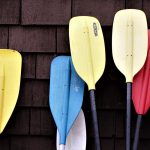Improper storage can damage your precious canoe. Our canoe storage guide will help you make sure your canoe stays as good as new for as long as possible.

New to paddle boarding? Excited to get out on the water and try your paddle board for the first time but aren’t sure what to expect or how to master the basics?
You’re in luck–we’ve got a complete guide to paddleboarding for beginners written just for you!
Below, we’ll walk you through all the essentials: what you’ll need, how to stand up and stay balanced, how to wield your paddle like a badass, and more. Everything you need to start paddling comfortably today, we’ll dive into below.
By the end of this post, you’ll be ready to get out on the water and get your stand up paddle boarding on like a boss.
3 Reasons Why You’ll Love Paddle Boarding

1. It’s easy and fun.
With stand up paddle boarding, there is a small learning curve to master the balance and paddling. However, once you’ve mastered the basics (which will be easy thanks to our paddle boarding tips below), you’ll find you can take your stand up paddle board anywhere and have a whole lot of fun using it.
2. It’s amazing on hot summer days.
I’m pretty sure all paddle boarders will agree with me: when the sun is up and the water is warm, there’s nothing quite as spectacular as paddle boarding.
With kayaking or canoeing, you’re inside a vessel that keeps you away from/out of the water. But on a paddle board, you’re in direct contact with the water, so you can jump off your board to cool off or go for a relaxing swim, then hop back on and continue paddle boarding.
It makes for a game-changing summer!
3. It’s a travel-friendly water sport.
Thanks to the advances made in inflatable paddle boards, you can now travel anywhere and paddle board any time. Just throw the suitcase-sized paddle board into the trunk of your car and you’re good to go. Heck, you can even take it on the bus or train for an easy commute to and from the nearest body of water.
Because they’re so ultra-compact, inflatable SUPs make it easy to take your paddleboarding anywhere you want.
What You’ll Need for Your First Time Paddle Boarding
So, you’re off to your first day of stand up paddle boarding, and you’re packing all the essentials for the day. Only you might now know what those essentials are if it’s your first time on a paddle board.
Don’t worry, we’ve got your back.
Below, we’ve got a list of all the essentials you’ll need to pack for a day out stand up paddle boarding on a lake, river, or beach.
What to Pack:

If you can bring your own gear, excellent! If not, if you can’t complete this list below, it may be a good idea to rent gear in order to have a safe SUP adventure. It’s even more important if it’s your first SUP outing and you’re just learning the basics of paddle boards for the first time.
- The board. Kind of hard to go paddle boarding without paddle boards, right? Strap that paddleboard onto the roof rack, or throw the inflatable SUPs bags in your trunk.
- A paddle. You’ll need a SUP paddle, which is designed differently than a kayak paddle. Not only is the paddle blade shape different, but SUP paddles only one blade. The other end has a knobbed handle (T-bar) that provides you leverage as you paddle.
- Personal Flotation Device. If it’s your first time on a stand up paddle board, you can expect to fall off a few (or a lot of) times. It’s smart to wear a personal flotation device to ensure you’ve got the buoyancy to swim back to your board and climb on. (Note: Even if you’re a strong swimmer, you should still wear PFD while paddleboarding. Not only is it safer, it’s often required by Coast Guard law.)
- Safety Devices. Other safety devices that you may want to take paddle boarding include a safety whistle and a waterproof flashlight, both of which you can use to signal for help. You may also want to keep a kayak safety kit on hand. This kit contains the basic items for self-rescue, including a rope, flotation device, first aid kit, compass, and flashlight.
- SUP Leash. This is usually integrated into the board’s design (attached to a D-ring), but it’s still worth checking to make absolutely certain it’s there. The SUP leash connects you to the paddle board, keeping it from drifting away or being carried away by a current.
- Dry Bag. A dry bag gives you a safe, waterproof place to store the items you want to take onto the stand up paddle board with you: keys, smartphone, speaker (to enjoy music), snacks, food, dry clothing, etc. You can usually clip it to the bungee cords on the paddle board’s deck to keep it securely in place while you’re out on the water.
- Inflatable Pillow. If you’re like me and love to lounge on your board while out on the water, an inflatable pillow is an awesome addition to the gear you take out on the stand up paddle board with you. You’ll never be more comfortable when reading, tanning, or taking a nap.
- Board Bag. A paddle board bag will make it easy to transport your paddle board (non-inflatable) around. It typically features a built-in strap that you can sling over your shoulder for one-handed carry, freeing up your other hand for the rest of your gear.
- Sun Protection. In addition to the clothing you’ll wear to shield you from sun exposure (see the next section), you’ll also want to bring sunscreen out on the water with you. Over long hours of lounging, paddling, fishing, or SUP Yoga, your skin is at serious risk of sunburn without the protection.
- Water. Even if you’re just going to be out on your paddle boards for a few hours, it’s always smart to bring water. Between the hot sun and your exertion, you’re at risk of dehydration if you don’t have fluids handy.
What to Wear:
- Swim trunks or board shorts. You want something light that moves easily with your legs as you swim, paddle, and stand on your paddle board. If you’re planning on doing SUP Yoga, consider pants with greater elasticity so you can move freely.
- Rash guard or T-shirt. A rash guard can protect your upper body from friction as you ride your paddle board (useful for paddleboarding surfing), but at the very least, you want a T-shirt to provide basic protection from the sun.
- Long-sleeved shirt and pants. If you’re going to be out on the paddleboard all day (6+ hours), it’s smart to bring long-sleeved clothing and pants to A) keep you warm if the afternoon turns cool as the sun is setting, and B) to shield you from the sun. Too many hours of sun exposure can lead to serious sunburn, dehydration, and even heat stroke.
- Wetsuit or drysuit. If you plan on paddling in cold water (below 70F), you’re going to want a wetsuit or dry suit. A dry suit is ideal for those who plan to stay out of the water, while a wetsuit is the better choice for anyone planning on getting in the water.
- Sun protection. A hat is an absolute must-have to keep your head from getting burned, and a pair of sunglasses will shield your eyes from the bright sunlight coming from both overhead and reflected off the water.
Dress right, and you’ll have a much more enjoyable day out on the water!
How to Stand Up on a SUP for the First Time
So, you’ve got your paddle boards out on the water and you’re attempting to stand up for the first time. It will definitely feel tricky and shaky at first, but the beginner stand technique is actually a lot simpler than you might expect.
We’ll get into the paddle technique in a later section. For now, this section of paddle boarding tips is just focusing on how to stand up on the SUP board.
Time to break it down step by step:
Step 1: Start in shallow water. You want to be in water deep enough that the fin doesn’t scrape or drag against the bottom, but not so deep you’re afraid to fall in. Try to aim for calf to knee depth.
Step 2: Climb aboard. Start by standing next to your paddle board. Set your paddle down across the front of your board. Place both hands firmly on the paddleboard and place one knee on the center point of the board–“center” both length and width-wise. Shift your weight onto your planted knee, and bring your other knee up beside it. Spread your knees slightly to roughly hip width (or shoulder width, if that feels more comfortable). Stay in this kneeling position and focus on feeling the way your board wobbles and tilts beneath the weight of your body and the movement of the water.
Step 3: Stand up. Time to shift from kneeling to standing position! With a paddle board, you don’t need to jump up to standing as you would on a surfboard as you ride waves. Instead, place one foot firmly on the deck while keeping the other knee bent. You can use the paddle as a support, if you want, as you slowly stand and plant your other foot. Keep your feet parallel to each other and near the middle of the board.
Step 4: Find Your Balance. Expect to feel very unsteady at first; that’s just part of the paddleboarding experience. Focus on controlling your body weight, keeping your knees bent and soft so you can shift your weight as needed to maintain balance. Lift your head and straighten your back to stand straight. You can use the paddle like a tightrope walker’s pole if that helps you keep your balance.
And just like that, you’re up! The first hurdle is done and conquered. Now it’s time to get paddling.

Holding Your SUP Paddle the Right Way
Before we can get into the actual paddling strokes, we’ve got to talk about the SUP paddle–specifically, how you should hold it.
As you can see, an SUP paddle is different from a kayak paddle. It’s got just one head rather than two.
Really, you can think of it as a canoe paddle, just with a much longer handle. That longer handle is necessary because you paddle a canoe sitting down and paddle boards standing up.

For the correct paddle grip:
- Start with your dominant hand (for me, it’s my right, but it might be your left) gripping the T-bar/knobbed handle. The handle should conform to your palm so it sits comfortably in your hand as you’re paddling.
- With your off-hand (my left), grip the paddle roughly halfway down the handle. Hand positions will change slightly from person to person–you’ll have to test it and find what feels most comfortable for you–but for now, try to aim for that halfway mark.
- Face the paddle blade the right way. The angle of the blade should be turned away from you (opposite to how you’d hold a kayak paddle, blade forward rather than backward). Not only will this make for more efficient paddling, but the T-bar handle will fit more comfortably into your hand.
The Basic Paddle Board Strokes You Need to Know
So, you’re standing up and (mostly) balanced, you’re holding the paddle board paddle correctly, so now comes the time when we get to talk about the basic strokes you need to master.
If you’re doing hardcore whitewater paddling, then you’ve got a lot steeper learning curve ahead. But for the average paddler–doing SUP Yoga, SUP fishing, or just recreational paddle boarding–you really only need to know a few simple strokes:
Forward Stroke
The forward stroke is the simplest stroke, and the one you’ll be most likely to use. After all, you’re spend most of your time propelling your board forward–it’s rare for you to paddle backward.
The basic paddling techniques of the forward stroke are:
- Engage your core strength to maintain your balance and provide something solid to push against. (Paddle boarding can be quite a good core workout for this reason alone!)
- Extend the paddle forward with your arms straight, and dip the head fully into the water.
- Keep your knees slightly bent as you lean forward and pull the paddle toward you. Pull until you reach roughly your ankle, then pull it out of the water and extend it forward once more.
Just like that, you’re propelling the board forward!
You will never go in a straight line on a paddle board because of the way you paddle. Typically, you paddle 3-5 strokes on one side of the board, then switch hands and switch sides for another 3-5 strokes on the other side. It’s a more zig-zagging form of paddling than kayaking, which is why most SUP boards are built for recreational use, SUP surfing, or SUP Yoga rather than long-distance paddling.
However, with the forward stroke, advanced paddlers on SUP touring boards can learn to cover quite a lot of distance at a good speed.
Turn Stroke
To turn the paddle board (the simple way), you simply maintain the forward stroke, but only one on side rather than switching sides.
To turn right, paddle repeatedly on the left. To turn left, paddle repeatedly on the right.
It will make a slower, wider turn, but you’ll have no trouble maintaining your balance.
For a faster turn, you can drag your paddle on one side of the board.
For example, let’s say you want to make a sharp right turn. Paddle a few strokes on the left, to get your board moving forward and beginning to turn right. Then, quickly switch sides and drag the paddle on the right side of your board and behind you. The board will tip slightly (making it harder to keep your balance), but you will turn much more sharply to the right than if you’d only paddled on the left.
Reverse Stroke
The reverse stroke is rarely used to travel backward (because you don’t really go backward on paddle boards). Instead, it’s typically used more to slow you down, stop, or turn.
The reverse stroke is basically the mirror of the forward stroke:
- Reach the paddle behind you and submerge the blade fully into the water.
- Keeping your arms straight, twist your torso to push off against the blade (rather than pulling it forward toward you).
- Push until the blade passes your ankle, then retract it from the water and repeat.
If you’re moving forward, you can use the reverse stroke to slow down. A few strokes will stop you completely, though it will also cause you to turn slightly to the right or left (depending on which side you’re paddling).
Sweep Stroke
The swept stroke is a more advanced stroke, but one that’s absolutely essential to master in order to get better at making faster turns without slowing down.
Dragging your paddle (as you learned above) will enable you to make sharp turns, but will diminish your forward momentum. A sweep stroke (or reverse sweep stroke) won’t, so you’ll be able to continue zipping forward at top speed while still making faster turns.
For the sweep stroke:
- Plant your paddle in the water as you would with the forward stroke.
- Instead of pulling the paddle directly toward you along the length of the board, sweep it out to the side, creating a wide arcing motion. Use the leverage in your hips and legs to rotate the board’s nose.
- Remember: the sweep stroke will push the board quickly in the opposite direction–so if you want to turn left, paddle on the right side, and vice versa.
With the reverse sweep stroke, you start with the paddle behind you and perform that wide arcing stroke as you bring the paddle forward. You’ll turn in the same direction with this stroke, but it will sap some of your forward momentum.
Cross Bow Stroke
The last of the beginner paddling techniques you’ll want to master is the cross bow stroke.
A cross bow stroke has nothing to do with crossbows (sadly!). Instead, it refers to your paddle crossing over the bow (or nose) of the paddle.
With the cross bow stroke, you paddle using the normal forward stroke, but you don’t switch hands. Instead, you twist your body as you dip your paddle into the water on the opposite side of the board for a few paddle strokes before returning to the original side.
This stroke can be useful for staying on course while keeping good forward momentum. With the blade fully submerged in the water and your body coiled/twisted in this position, you can get quite a lot of power.
It’s also useful for making sharp turns without having to switch hands or change up your paddle grip.
Staying Balanced While Paddle Boarding
Getting up on paddle boards is just the first step; you’ve got to stay up!
Keeping your balance may be a bit tricky at first, but with practice, you’ll get better.
Here are the basics to keep in mind as you paddle:
Plant Your Feet Right
Ideally, you want to plant your feet directly beneath your hips (not shoulder width apart), or even slightly closer. This way, your body weight is in the center of the board, less likely to tilt side to side.
For best balance, you can try turning your toes slightly outward rather than keeping your feet parallel.
Stay Soft in the Knees
Keeping a slight bend in your knees will not only help with your balance, but also improve circulation and make it easier to stay upright on your paddle board for longer. It’s important if you plan on paddling a long distance.
Paddle More With Your Core
The power for your strokes shouldn’t come primarily from your arms. Instead, plant your legs as the base and use your core to pull or push against the paddle. Your arms will provide only a fraction of the effort.
Done right, it’ll feel like a full body workout, but the focus will be chiefly on your core.
Brace Against Your Paddle
If you ever feel yourself wobbling, try using your paddle to maintain your balance (like a tightrope walker).
However, the best way to stay balanced is to keep paddling. Every time you dip the paddle in the water and begin pulling, the water provides enough resistance that it almost feels solid, so you can brace against it. It’ll be much easier to maintain your balance as long as you keep paddling.
Or, if you ever need to, lean the paddle against your board and use it as a “third leg” to support yourself.
Drop To Your Knees
When you feel yourself wobbling, you don’t have to stay upright. Instead, drop to your knees (or hands and knees). Lowering your center of gravity makes it easier to maintain your balance.
Falling Off Your Paddle Board (And Getting Back Up Again)
Everyone falls off their paddle board the first few times. Heck, even experienced paddlers sometimes fall.
There’s no shame in falling. All you have to do is get back on the board and get back to paddleboarding.
Here’s how to fall and re-mount correctly:
Step 1: Fall to the sides. If you can, try to fall to either side of your paddle board. Let your body go limp as you hit the water.

Step 2: Hang onto your paddle. The leash is tethering you to your board, but the handle will float away if you don’t hang onto it.
Step 3: Climb back onto the paddleboard. It’s actually a much easier task than trying to re-mount a kayak. Just slide the paddle up onto the board, grab onto the carry handle most paddleboards have in the center, and use that to drag your body up onto the board. If you can, keep the paddle tucked beneath the bungee cords so it doesn’t slide off when the board tilts beneath your weight. Once you’re back on the board, shift back to your starting position (kneeling in the center of the board), and climb to your feet whenever you’ve regained your balance.
The beauty of stand up paddle boards is that they’re designed to remain upright and have high buoyancy (especially inflatable paddle boards or paddle boards with an EPS foam core). You won’t have to wrestle too hard to get yourself back up onto the deck, and you’ll be ready to try again.
Smart Tips for Beginners to Paddle Boarding
Paddle in the Right Weather
Avoid heavy winds and rainfall. Wind will stir up the surface of the lake, river, or ocean, making it hard to paddle and maintain your balance. Heavy rains can be uncomfortably cold (especially when the wind is added). Rainfall can also lead to a rise in river levels and current speed.
Paddle in the Right Conditions
If you’re a beginner, paddle in calm conditions, on a slow-moving river, the flat water of a lake, or a beach with minimal waves. You’re already going to have a hard enough time maintaining your balance without adding in fast-flowing currents, waves, or riptides.
Bring a Friend
Paddling alone–especially as a newbie, but even when more advanced–is never a good idea. There’s no telling what sort of risks you’ll face: heavy winds, high currents, underwater obstacles that damage your board, injuries, even dangerous animals. Only paddle when you have at least one other person with you.

Make the Paddle the Right Length
One of the biggest newbie mistakes you can make is setting the paddle length wrong.
If the paddle is too long, you’ll have to raise it very high to get it over the board, which will tire you out faster. Plus, you won’t be able to bring your full body to bear, so you’ll generate less power with every stroke.
If the paddle is too short, you’ll have to lean far forward to submerge it fully, which will A) tire you out faster, and B) increase your risk of lower back and knee strain.
So what’s the ideal length?
- For flatwater or recreational paddling, the paddle should be roughly your height plus 8-10 inches.
- For SUP surfing, set it to your height plus 6-8 inches.
- For SUP racing or touring, set it to your height plus 10-12 inches.
Use the Right Paddle Board Size and Type
We could spend a lot of time talking about how to choose the right paddleboard–in fact, we have, in two different articles: Types of Paddleboards and How to Choose a Paddleboard.
Both articles are well worth the read, as they’ll provide you with an in-depth guide on everything that goes into making a paddle board the perfect board for you (planing hull vs. displacement hull, pointed nose vs. round nose, carbon fiber vs. fiberglass vs. plastic body, whether you need one or more fins, and the list goes on).
For the sake of brevity, though, here are the most important factors to take into account:
SUP Types
Paddle boards come in a variety of types, each designed for a specific purpose:
- Recreational paddle board, ideal for flat water and calm lakes and rivers.
- Fishing SUP, designed wider and longer to be more stable and accommodate fishing gear.
- Yoga board, with a wider deck pad and longer body that is stable enough for Yoga poses.
- Surf SUP, leaner and sleeker and speedier, designed to ride ocean waves.
- Whitewater paddle board, built tough enough to withstand impacts and agile enough to make sharp turns.
- Racing/touring paddleboard, better for greater speed and longer distances.
Choose the type of paddle board according to the activity you plan to use it for.
SUP Sizes

Both the length and width of the paddle board matter.
- Longer boards track straighter but turn slowly.
- Shorter boards are more agile and make speedier turns, but aren’t great for long-distance travel.
- Narrow boards are sleeker and faster, but tend to be less stable.
- Wider boards are more stable but will move and turn more slowly.
Hard-shell vs. Inflatable SUP
Inflatable SUPs are an amazingly portable option; just throw them into their luggage-sized bag, and you’re off for a day on the water. However, they aren’t as durable, and not as well-suited to more advanced paddleboarding (i.e., whitewater, racing, or touring).
Hard-shell SUPs are bulkier, heavier, sturdier, and far less portable. You’ll need a large vehicle and/or roof rack to transport them. However, for more advanced activities (i.e., whitewater, racing, or touring), they’re the best choice.
Everything else, I strongly recommend you learn in the fully in-depth, detailed information we provide in the two articles: Types of Paddleboards and How to Choose a Paddleboard.
Avoid These Common Beginner’s Mistakes
Before we go, I want to share with you some of the silly newbie mistakes I made when I first started paddleboarding, which I wish someone would have warned me against. These mistakes can make paddleboarding a lot challenging!
Mistake #1: Holding the Paddle the Wrong Way
If you hold the paddle the wrong way (the blade facing toward you, like you would with a kayak paddle), every stroke will be significantly less efficient as well as significantly more challenging. Make sure the curve of the paddle is facing away from you for a more efficient stroke.
Mistake #2: Facing the Wrong Direction
This isn’t like rowing a boat; you don’t face backward. Always stand facing the direction you want to go–it’ll make paddling easier and help you stay on course when you can see where you’re going.
Mistake #3: Over-Relying on Your Arms
Trust me: if you work your arms more than your core and legs, your shoulders, biceps, and forearms are going to run out of steam after just a few minutes of paddleboarding.
Your core should be the primary power source, and you can use your legs and back muscles to add some extra “oomph” with every stroke. Really, your shoulders and arms should just be providing mobility, not strength.
Mistake #4: Paddling from a “Surf Stance”
Do not turn to the side and plant your feet the way you would on a surfboard, even when surf paddleboarding. Paddleboards are longer, wider, and more stable than surfboards, which also mean less agile. The paddle will do the turning for you to help you ride the waves. Your feet should remain side by side, facing straight forward, to maintain your balance.
Mistake #5: Spreading Your Feet Too Wide
This rookie mistake had me stumbling and toppling for hours before I finally learned the secret. If you spread your feet too wide, your weight is distributed toward the outer edges of the board, meaning you’re more likely to overbalance and topple.
Keeping your feet closer together, directly beneath your hips, not only keeps your weight planted firmly in the stable center of the board, but also makes it easier for your muscles to make the micro-adjustments necessary for maintaining your balance.

